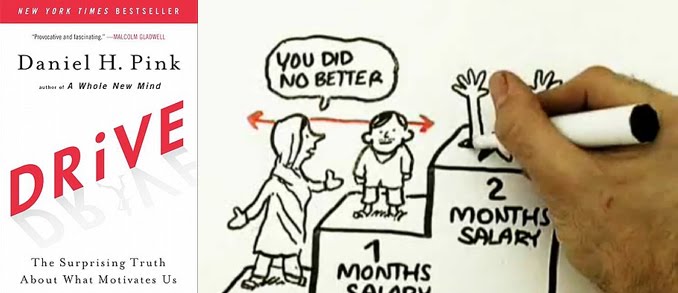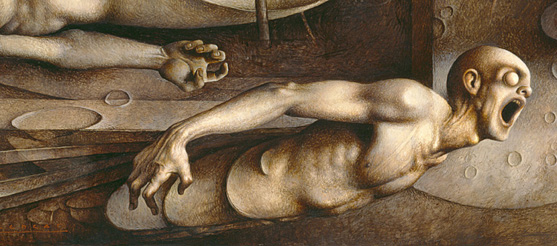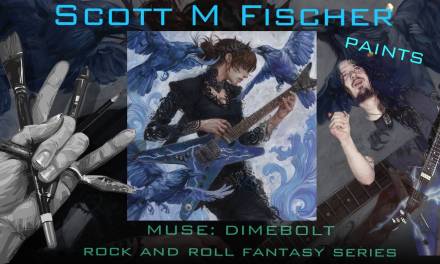by Eric Fortune
I’ve been reading some interesting literature on the science of motivation in human behavior. The book is “Drive: The Surprising Truth About What Motivates Us” by Dan Pink. In the book Dan presents what four decades of scientific research tell us about what it is that motivates humans.
For a quick intro into extrinsic and intrinsic motivators and how they affect us here’s one of my favorite RSA videos.
So how is this relevant for artists and other creatives? Below is an excerpt from the book “Drive”.
“Something similar seems to occur for challenges that aren’t so much about cracking an existing problem but about iterating something new. Teresa Amabile, the Harvard
Business School professor and one of the world’s leading researchers on creativity, has frequently tested the effects of contingent rewards on the creative process. In one study, she and two colleagues recruited twenty-three professional artists from the United States who had produced both commissioned and noncommissioned artwork. They asked the artists to randomly select ten commissioned works and ten noncommissioned works. Then Amabile and her team gave the works to a panel of accomplished artists and curators, who knew nothing about the study, and asked the experts to rate the pieces on creativity and technical skill.
“Our results were quite startling,” the researchers wrote. “The commissioned works were rated as significantly less creative than the non-commissioned works, yet they were not rated as different in technical quality. Moreover, the artists reported feeling significantly more constrained when doing commissioned works than when doing non-commissioned works.” One artist whom they interviewed describes the Sawyer Effect in action:
Not always, but a lot of the time, when you are doing a piece for someone else it becomes more “work” than joy. When I work for myself there is the pure joy of creating and I can work through the night and not even know it. On a commissioned piece you have to check yourself—be careful to do what the client wants.
Another study of artists over a longer period shows that a concern for outside rewards might actually hinder eventual success. In the early 1960s, researchers surveyed sophomores and juniors at the School of the Art Institute of Chicago about their attitudes toward work and whether they were more intrinsically or extrinsically motivated. Using these data as a benchmark, another researcher followed up with these students in the early 1980s to see how their careers were progressing. Among the starkest findings, especially for men: “The less evidence of extrinsic motivation during art school, the more success in professional art both several years after graduation and nearly twenty years later.” Painters and sculptors who were intrinsically motivated, those for whom the joy of discovery and the challenge of creation were their own rewards, were able to weather the tough times—and the lack of remuneration and recognition—that inevitably accompany artistic careers. And that led to yet another paradox in the Alice in Wonderland world of the third drive. “Those artists who pursued their painting and sculpture more for the pleasure of the activity itself than for extrinsic rewards have produced art that has been socially recognized as superior,” the study said. “It is those who are least motivated to pursue extrinsic rewards who eventually receive them.”
This result is not true across all tasks, of course. Amabile and others have found that extrinsic rewards can be effective for algorithmic tasks—those that depend on following an existing formula to its logical conclusion. But for more right-brain undertakings— those that demand flexible problem-solving, inventiveness, or conceptual understanding—contingent rewards can be dangerous. Rewarded subjects often have a harder time seeing the periphery and crafting original solutions. This, too, is one of the sturdiest findings in social science—especially as Amabile and others have refined it over the years.10 For artists, scientists, inventors, schoolchildren, and the rest of us, intrinsic motivation—the drive do something because it is interesting, challenging, and absorbing—is essential for high levels of creativity. But the “if-then” motivators that are the staple of most businesses often stifle, rather than stir, creative thinking. As the economy moves toward more right-brain, conceptual work—as more of us deal with our own versions of the candle problem—this might be the most alarming gap between what science knows and what business does.”
I find this type of research fascinating. If you’re low on time for reading but are looking for more insight on the topic here’s a more in depth Google Talk where Dan states
“Being an artist is really, really hard ok? Doing anything well is really, really hard. It’s takes a really long time. And you’re less likely to stick with it if you don’t really love it. And so, because they really loved it, it was “what I do”, they got a lot better at it. “
If you do have time and are looking for more there’s one other book on my reading list dealing with the affects of extrinsic motivators and incentives called “Punished by Rewards” by Alfie Kohn. For all the students out there grades are indeed a form of reward. So what does research say about the affect grades have on motivation? You might want to check out Alfie’s book from your local library to understand more and maybe even share it with your teacher.








Daniel Pink is amazing, I've seen him speak before. I'm going to go have to read that book now definitely. Great advice/insight, thank's Eric.
Colleen- I love this stuff. If you google the book you should be able to find a pdf online:)
Part of me feels more like you can learn to love a task just by doing it more often.
A couple years ago I set myself the goal of filling a sketchbook with mostly gesture drawings or more personal non-job related work over the summer. Before this I mainly only would draw when I had a job to work on, but I wanted to get better and that was my goal. I would fill a page or two a day by going out and drawing in public or drawing at home. The subject matter didn't always matter but I remember I was mainly drawing people. After some time and I had met my goal of filling that one sketchbook I realized that I enjoyed the task of drawing more then I ever had in the past.
It's getting past that initial fear of doing a bad drawing or painting that is the hard part. The best thing I've found for that is by just saying to myself “do the task for 5 mins and see what happens”. But it's good to actually set a timer for this IMO.
Good post! I had just watched that RSA video yesterday! Very interesting stuff. It seems like you could grade students on the number of drawings or projects they complete rather than the success of one final would be a better way to get better artists which would be the goal.
So are they gonna pay us less in order to better art now? :S Or is hte idea to do smth for a higher purpose and thus it will be greater and better? Because YES it is so- I mean just expressing what you hold withing, what is trying to make its way out of you and shout out loud to the World “Hey that is me! This painting is me you know, this is how I like things, how i imagine them in my OWN world” then forcing yourself to do smth for money…the 1st one always turns to be better piece of art. I dont know about you but prices do motivate me , but they can't rly make me creative if I dont feel the subject. I guess deep withing our Artistic spirit doesnt give two shits about stupid arse money you know…it just “wants out” m/
Thanks for the incredibly insightful article. I really appreciate it.
This post is an example of why “Muddy Colors” is the best blog out there. Interesting, insightful, surprising, helpful- I could go on. You guys are just great.
Thanks for sharing this post, eric! I love both of those videos. There is an audiobook of “Drive” btw… also another good companion to this book is 'The War of Art' by Steven Pressfield & 'Mastery' by George Leonard. 🙂
Love your 5 min. statement, my mantra has always been – do it for 10 mins and chances are you'll keep going. I'm going to try the “fill a sketchbook” – great advice.
Eric, thank you for this post! I bought the book (love my kindle!) and I'm about 1/3rd through and it is hitting the things that have always bothered me about my jobs. What is really exciting is how this is helping me to adjust my attitude toward doing commissioned work. I keep hearing the advice “find a way to make it your own” and this just reinforces that idea and it's making the reluctance to do commissions drain away – I'm actually getting more excited about it now! I always was a type B peg being shoved into a type A hole and now I know I don't have to be! Thanks again!
@James O'Shea – YES that is a GREAT book (War of Art) and it does resonate beautifully with this one. I'm going to check out the “Mastery” book as well. I made a poster of the main points from War of Art to keep by my work area – it helps!
Thanks for posting this! Since watching these videos I've been thinking about motivators both in the context of my own art business and at the IT company I work for. Great food for thought.
These video is dope. But, who did those cartoons? He is awesome!
Awesome Book Eric – thanks for recommending it! I totally agree with James about 'The War of Art' by Steven Pressfield & 'Mastery' by George Leonard being good companion books.
I have a job that I do relatively competently and my significant other seems to think I do a great job of it. The problem is it's “only a job” to me so I find my enthusiasm is intermittent. I tell my significant other that I am only “ok” at my job and there will always be people better than I am because they “Love” this field of work whereas for me it's only a job. I understand the difference between extrinsic motivation (pays the bills) versus intrinsic (If I enjoy my job, is it really work?).